skip to main |
skip to sidebar
Overall description
Myanma Railways are committed to a number of projects to build new railways to improve communications in Myanmar. One of these projects is providing a railway line from Katha (on the west bank of the Ayeyarwaddy River) to Bhamo (further north, on the east bank of the Ayeyarwaddy River).
Katha is already served by an existing branch line from the junction at Naba with the line from Mandalay to Myitkyina in Kachin State.
The line from Katha to Bhamo was started in May, 2007. The work is divided into three sections: Katha-Kyautkyi (length 37.06 miles), Kyautkyi-Simkhan (28.26 miles) and Simkhan-Bhamo (29.56 miles), giving a total length of 94.88 miles.
Section 1. Katha - Kyautkyi: The line from Katha to Moe Tar Kyi line opened on 20th October 2010 and from Moe Tar Kyi to Kyautkyi line on 7th February 2014. There are 141 bridges in this section. 132 bridges have a span of less than 40 feet, 8 bridges have a span between 40 and 180 feet and one bridge has a span exceeding 180 feet.
The line is controlled by the following Block Stations: Katha, Paw Ma Myaing, Min Le, Moe Tar Kyi, Choung Wa and Kyautkyi. These stations are provided with fixed distant signals and working Outer Signals. Block Working uses paper 'Line Clear' forms.
A regular passenger service is now operated on this section by diesel railcars type RBE (brief details in the post Diesel Railcars in Burma). The Line Speed Limit is currently 15 miles/hour. The line from Katha to Choung Wa is in Sagaing Division: beyond Choung Wa, the line is in Kachin State.
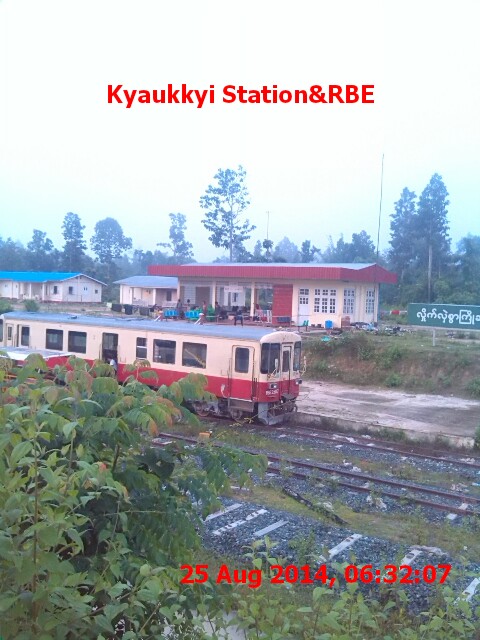
Kyaukkyi Station, Myanmar (Photo: Htein Lin)
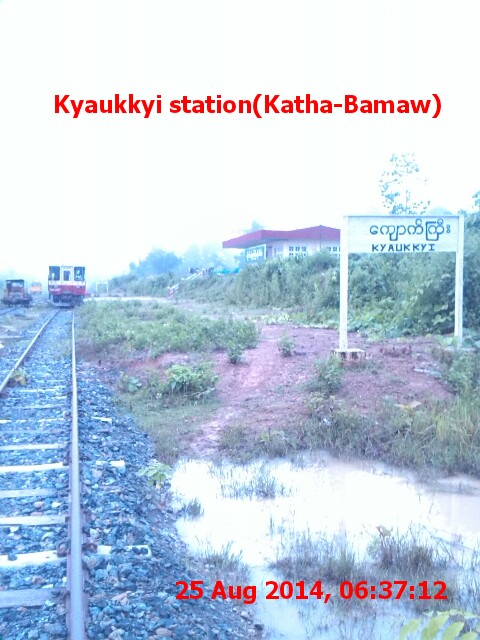
Kyaukkyi Station, Myanmar (Photo: Htein Lin)
Section 2. Kyautkyi - Simkhan: This section has 129 bridges, all completed. This section will have Block Stations at Myo Kone and Simkhan. Stations and signals will be similar to section 1.
Section 3. At Simkhan, a major road/rail bridge across the Ayeyarwaddy River has been built. The remainder of section 3 to Bhamo is under construction.
The new junctions at Katha
I've made two round trips from Katha to Naba, both times on special trains operated in connection with 'Road to Mandalay' river cruises. The first railway trip was in 2010 (when I travelled in the locomotive cab) and those journeys are described in the (technical) posts Cab Ride from Katha and Cab Ride back to Katha. Two years later, I repeated the trip, described in the post By Train to Naba. Each of these posts has links to the associated photographs.
On the first railway trip in 2010, I was intrigued to discover an unexpected triangular railway junction about 3.5 km from the terminus at Katha.
The photograph below was taken from the locomotive cab on the return journey from Naba to Katha in 2010 shows the new line to Bhamo trailing off to the left. There is a handsignalman, the usual single lever to operate the junction points which are then secured with a point clip. 'Stop' signals are provided but were not operated - the handsignalman giving a Green Flag as authority to proceed. The bamboo shelter at the junction appears to be for the handsignalman's use.
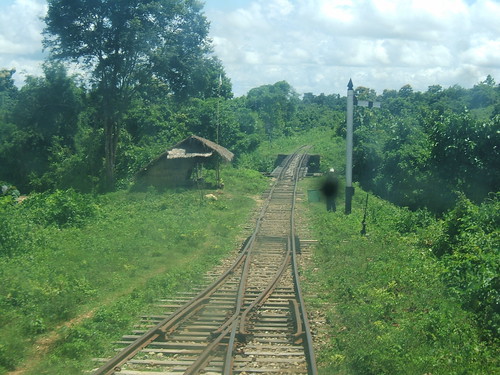 The new junction viewed from a train on the Naba to Katha line, looking towards Katha showing the new line to Bhamo trailing off to the left.
The new junction viewed from a train on the Naba to Katha line, looking towards Katha showing the new line to Bhamo trailing off to the left.
The photograph below, taken from the train on the Naba to Katha line in 2012, shows the new line to Bhamo curving away to the right. Note the single point lever controlling 'trap' points which, when open as in the picture, will derail any vehicles approaching the junction from the new line, providing 'flank' protection to a train on the Naba to Katha Line. A 'Stop' signal is also provided.
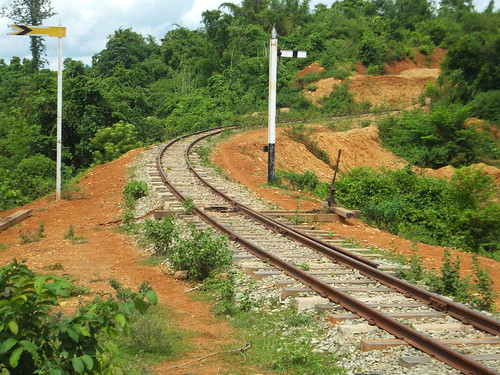 The new line to Bhamo curving away to the right, viewed from a train on the Naba to Katha line.
The new line to Bhamo curving away to the right, viewed from a train on the Naba to Katha line.
The photograph below, taken from the train on the Naba to Katha line in 2012, shows the 'third side' of the triangle, which would allow a train from Naba to divert towards Bhamo, rather than proceeding to Katha. Note mix of timber and concrete sleepers. The undergrowth between the rails testifies to the line not being in regular use.
 The 'third side' of the triangle, viewed from a train on the Naba to Katha line.
The 'third side' of the triangle, viewed from a train on the Naba to Katha line.
The new bridge at Simkhan
In 2012, I visited Bhamo on the 'Road to Mandalay' cruise ship and I took the photographs below of the Simkhan bridge, commenting:-
"We passed under the New Bridge which appears almost complete. There are eight steel truss spans but only the one we used was marked for river traffic. There were 'traffic lights' on the bridge piers but they were not lit. The bridge carried a lane for road traffic (equipped with lighting standards), a single track metre gauge railway and a pedestrian lane. On either side of the bridge spans, there are reinforced concrete approach viaducts. I was told that the railway track on the west bank will be connected to the triangular junction at Katha and will be extended to Bhamo on the east bank."
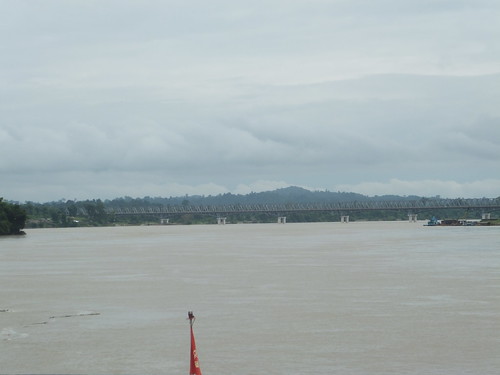 The Simkhan Road/Rail Bridge, Ayeyarwaddy River.
The Simkhan Road/Rail Bridge, Ayeyarwaddy River.
 West bank of the Ayeyarwaddy River, showing the Simkhan Road/Rail Bridge.
West bank of the Ayeyarwaddy River, showing the Simkhan Road/Rail Bridge.
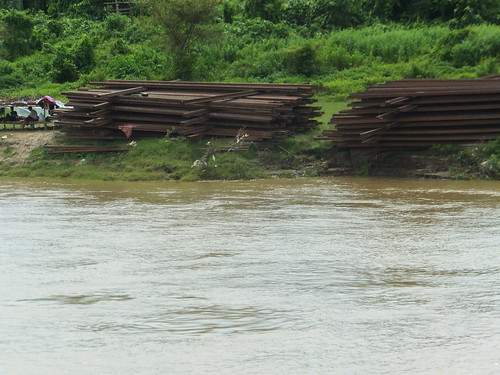 Rails stockpiled, awaiting use: Simkhan Road/Rail Bridge, Ayeyarwaddy River.
Rails stockpiled, awaiting use: Simkhan Road/Rail Bridge, Ayeyarwaddy River.
Acknowledgments
I am grateful to Myanma Railways staff for providing much of the information in this post but any errors are my own.
Related posts on this website
I've made two visits to Bhamo by river (on the 'Road to Mandalay' cruise ship) in 2010 and again in 2012. There are a number of (non-technical) posts on these trips - those for 2010 are here and those for 2012 are here. These posts have links to photograph albums where there are more pictures of the railways and river bridge.
India is a huge country with an important and extensive railway system largely inherited from the British. On my three visits to India to date, I've seen only a tiny part of the railway system.
1992 trip
My first visit in 1992 was a business trip in connection with the commissioning of telecommunications equipment around Delhi for the railways. There's a very brief outline of the amazing seven weeks I spent in India here. I eventually added to that report here, but it's still rather sketchy. Railway highlights were a visit to the National Railway Museum, set up by Mike Satow, and 'hands on' both metre gauge and broad gauge steam locomotives.
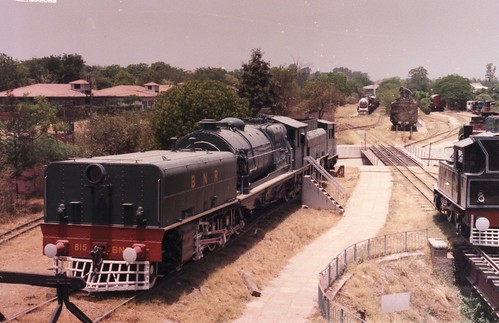 Manchester-built Beyer-Garratt (works number 6594/1930) in Delhi Railway Museum.
Manchester-built Beyer-Garratt (works number 6594/1930) in Delhi Railway Museum.
 On a 'WP' from Delhi: applying the vacuum brake as we approach a red signal.
On a 'WP' from Delhi: applying the vacuum brake as we approach a red signal.
Railway Photographs from the 1992 trip
There are a number of albums of photographs, all scanned from prints taken by a pre-digital ('wet film') Canon EOS.
National Railway Museum, Delhi (1992)
Broad Gauge around Delhi.
Shahdara Junction, Delhi.
Metre Gauge around Delhi.
Driving a 'WP' in India.
2006 trip
My second visit was a very short affair, crammed into my third 'Round the World' Trip. There's a very brief and non-technical description in the post Round The World Three. On Saturday 25th February 2006, I made my second visit to Delhi Railway Museum.
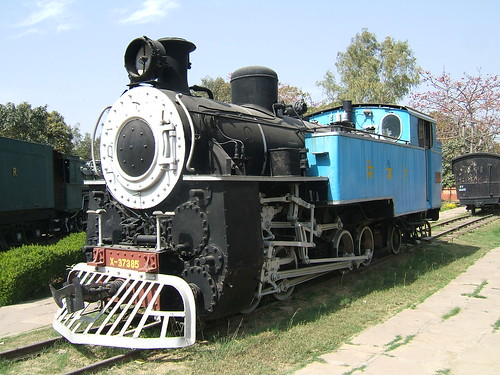 A remarkable 4-cylinder narrow gauge mountain railway locomotive in Delhi Railway Museum.
A remarkable 4-cylinder narrow gauge mountain railway locomotive in Delhi Railway Museum.
The following day, I took the 'Shatabdi' broad gauge electric to Kalka, changing there to the 2ft 6in gauge train to Shimla. There's a Wikipedia article on the Kalka - Shimla Railway here.
 The Kalka - Shimla Railway.
The Kalka - Shimla Railway.
Railway Photographs from the 2006 trip
Once again, there are a number of albums of my railway pictures:-
National Railway Museum, Delhi (2006).
Northern Railways, India.
Kalka-Shimla Railway.
2009 trip
In 2009, I was back in India, this time staying in Kolkata (formerly Calcutta) just one night on my way to Bhutan. There's a short post on Kolkata here. In a rather hectic day of sightseeing, I made a visit to the famous Howrah Railway Station and, close by, Kolkata Rail Museum.
 The imposing facade of Howrah Station Building.
The imposing facade of Howrah Station Building.
 Kolkata Rail Museum.
Kolkata Rail Museum.
Railway Photographs from the 2009 trip
Howrah Station, Kolkata.
Kolkata Rail Museum.
Books
For an excellent introduction to the variety of railway locomotives which have served India over the years, see Hugh Hughes 4-part work 'Indian Locomotives', which is briefly outlined here.
In March 2008, I made my first visit to Myanmar (formerly Burma) and made my first trip on Yangon's Circle Line, described here. The comments I made at the time about the trackwork were not very kind, I'm afraid.
"Whilst the track isn't too bad near the main station with a fair amount of concrete sleepers and modern rail fastenings, it deteriorates further out. Here, rails are frequently spiked to elderly wooden sleepers which are quite widely spaced and with indifferent ballasting. Rail gaps are very variable (sometimes with a short piece of rail plugging the gap) and with frequent missing fishbolts, as my photographs show. I'm afraid these standards are typical of the infrastructure in Myanmar, which has suffered from years of neglect."
I'm happy to report that matters have improved somewhat since 2008 but the condition of trackwork is still an issue. I've not seen modern equipment for tamping and lining which may be a factor.

DMU Cab Ride on the Circle Line: View of concrete sleepered track and shallow ballast.
Burma can source various hardwoods for sleepers. Traditionally, Pyingado was used, described as "one of the most valuable Burmese timbers, second only to teak. It produces very large trees, 100 to 120 feet in height and 8 to 12 feet in girth. At their best the boles are straight and fairly cylindrical. These trees grow in association with teak. The trees occur in the lower hill forests in Burma up to about 2,500 feet".
On pointwork, wooden crossing timbers are still used but, on plain track, concrete sleepers are used. These are produced at a number of locations in Myanmar:-
Khin U (Division 2)*
Myitnge (Division 3)*
Mohaung (Division 3)
Pa Kok Ku (Division 11)
Shwe Nyaung (South Shan State)
Motetamma (near Mawlamyine)*
Oo Shit Pin (near Pyi)
Pyon Tan Sar (on main line)
Total: 8 locations. The three sites marked with an asterisk are the principal production areas.
My pictures
A selection of Permanent Way pictures in Myanmar.
[Brief details of Pyingado added 3-Jul-2015]
In Part 3 of Hugh Hughes excellent guide to railway locomotives in India (introduced here), there is the following brief information about the Madaya Light Railway in Burma (now Myanmar).
The Madaya Light Railway was a 2 ft 6 in (762 mm) narrow gauge railway that terminated in Mandalay, Burma. The first section to Toungbyon, 8 miles long, opened in 1912. The railway was extended a further 8 miles to Madaya in 1917. The company operating the line went into liquidation in 1919, and the railway was taken over by the Government. The line was closed in 1927 when it was replaced by a metre gauge line
The first four locomotives for the line were obtained second hand from the Thaton – Duyinzaik Railway.
Locomotives 1 & 2 were 0-4-2 Saddle Tanks built 1882 by Barr, Morrison and Company.
Locomotive 3 was a 6-coupled well tank built 1885 by Dick Kerr and Company.
Locomotive 4 was another 6-coupled locomotive built in 1901 by Dick Kerr and Company.
Statistics for March 1921 listed seven locomotives but no information is available about the additional three locomotives.
Further details of the first four locomotives are given in the post Thaton – Duyinzaik Railway.
Myanma Railways still operate a passenger service on the metre gauge line from Mandalay to Madaya.
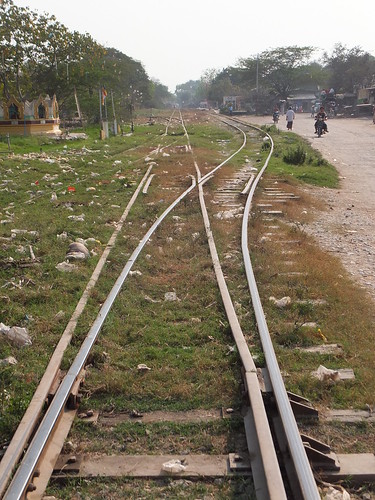
Owe Boe station on the metre gauge Madaya line looking towards Mandalay in 2013.
Pictures of Owe Boe station
Owe Boe Station, Mandalay.
In Part 3 of Hugh Hughes excellent guide to railway locomotives in India (introduced here), there is the following brief information about the long-gone Thaton – Duyinzaik line in Burma (now called Myanmar).
The Thaton – Duyinzaik Railway was a 2ft 6in (762 mm) narrow gauge railway opened in 1885 built and worked by Mr. George Dawson of Rangoon. From Thaton, the railway extended 8 miles east alongside a public road through jungle to Duyinzaik, connecting with a daily launch service also operated by Mr. Dawson to Moulmein.
In 1895 the inspecting officer reported:-
"Trains are not worked by any of the systems prescribed for railways. The Manager who lives at Duyinzaik controls the traffic and gives instructions directly to the drivers or by telephone to the station master at Thaton."
Locomotives 1 & 2 were built in 1883 and were 0-4-2 Saddle Tanks with two 7 x 12 inch cylinders, 22 inch diameter coupled wheels and 15 inch diameter trailing wheels with radial axleboxes. The wheelbase was 4 foot + 4 foot, overall length 15ft 6ins and weight was 8 tons. These are believed to have been built by Barr, Morrison and Company at Kilmarnock for W. B. Dick and Company and were described as ‘Flying Car’ type.
Locomotive 3 was a 6-coupled well tank with 8 x 16 inch cylinders built by Dick Kerr and Company, Preston in 1885, weighing 13 tons.
Locomotive 4 was also a 6-coupled locomotive built by Dick Kerr in 1901, weighing 10.75 tons.
In 1900 the Irrawaddy Flotilla Company took over the line until closure in 1907 when the metre gauge Burma Railways line reached Thaton. After closure, all four locomotives were transferred to the Madaya Light Railway.
Of course, Rangoon is now called Yangon, Moulmein is now called Mawlamyine and 'Duyinzaik' can be Romanised as 'Duyinzeik'. There's a brief post about the Madaya Light Railway here.
Seeking more information about the manufacturers of the first four locomotives, I turned to the internet resource Grace's Guide. This splendid site was started by Andrew Tweedie in 2007 with the exemplary Mission Statement "To be the premier on-line library of information regarding the Companies, People, Places and Products of the Industrial History of the UK and to preserve that information by making it freely available for all to use without restriction".
James Barr was certainly producing various types of machinery in Kilmarnock around that period.

1888 advert for James Barr (Source: Grace's Guide).
W. B. Dick and Company set up in Glasgow in 1854 and expanded to become 'oil refiners, merchants and factors, railway and tramcar builders'. John Kerr became a senior employee of W. B. Dick and Company and, in 1883, Dick, Kerr and Company was set up to take over the railway and tramway activities at Kilmarnock and later at Preston, continuing to build locomotives (including Locomotives 3 and 4 for the Thaton – Duyinzaik Railway) and also electrical equipment.
Although steam locomotive manufacture did not survive at Dick, Kerr and Company, the firm became well-known for their electrical equipment for railways and tramways. For instance, there are pictures here of the preserved Liverpool Overhead Railway Driving/Motor Car using Dick, Kerr electrical equipment. The English Electric Company Limited became successors of Dick, Kerr and, as late as 1944, the works plate on the battery electric shunting locomotive now preserved at the Museum of Science and Industry in Manchester reads "The English Electric Company Ltd. London, No. 1378 1944, Dick Kerr Works, Preston, England". My pictures of this shunter are here.
I later found a short article on the Thaton – Duyinzaik Railway here, on the interesting Families In British India Society (FIBIS) site.
[Link to FIBIS site added 27-Mar-2020]
Hugh Hughes produced an excellent guide to railway locomotives in India called simply 'Indian Locomotives'. This was published as a four-volume set of books with 'limp' covers by The Continental Railway Circle.

Brief details of these volumes are given below:-
Part 1 - BROAD GAUGE 1851-1940: First published 1990 (ISBN 0 9503469 8 5)
Part 2 - METRE GAUGE 1872-1940: First published 1992 (ISBN 0 9503469 9 3)
Part 3 - NARROW GAUGE 1863-1940: First published 1994 (ISBN 0 9521655 0 3)
Part 4 - 1941- 1990: First published 1996 (ISBN 0 9521655 1 1)
This comprehensive work gives dimensions, statistics and includes industrial locomotives. Part 2 includes Burma, part 3 includes minor railways in Burma and part 4 has sections on Bangladesh, Burma, Pakistan and Sri Lanka. All-in-all, an essential reference.
These books are available directly from The Continental Railway Circle. For further information go to their internet site here.
My own, rather modest, exploits to see Indian Locomotives on my three visits to India are outlined in a post here.
After a long interval, another in the series of 'occasional sessions' was held at Brewood on Thursday, 21st May 2015. For the first time, we welcomed professional railwayman and enthusiast Nick but, unfortunately, Keith was unable to be there.
 L-R: John, Ian, Nick, Phil, Mike.
L-R: John, Ian, Nick, Phil, Mike.
Ian showed us some remarkable photographs and plans he's unearthed which created a lot of discussion.
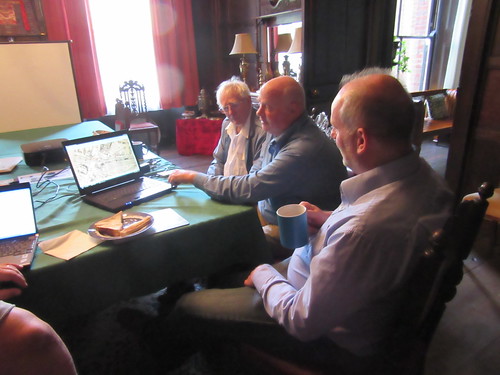 Ian talks about one of his interesting old maps.
Ian talks about one of his interesting old maps.
Ian's data is now spread over two portable hard drives. Later, we looked at some of Mike's data on his portable hard drive. Most of this information concerned the South Stafford line or the West Midlands. Nick had brought some of his wonderful drawings of signal box layouts, particularly on the former North Stafford. Having recently returned from Burma, Jan showed a few pictures of the metre gauge railways there.
Previous meetings have been held:
Sunday, 14 February 2010
Tuesday, 27 September 2011
Monday, 6 February 2012
Wednesday, 12 June 2013
A few pictures from these meetings can be found here.


 The new junction viewed from a train on the Naba to Katha line, looking towards Katha showing the new line to Bhamo trailing off to the left.
The new junction viewed from a train on the Naba to Katha line, looking towards Katha showing the new line to Bhamo trailing off to the left.
 The new line to Bhamo curving away to the right, viewed from a train on the Naba to Katha line.
The new line to Bhamo curving away to the right, viewed from a train on the Naba to Katha line.
 The 'third side' of the triangle, viewed from a train on the Naba to Katha line.
The 'third side' of the triangle, viewed from a train on the Naba to Katha line.
 The Simkhan Road/Rail Bridge, Ayeyarwaddy River.
The Simkhan Road/Rail Bridge, Ayeyarwaddy River.
 West bank of the Ayeyarwaddy River, showing the Simkhan Road/Rail Bridge.
West bank of the Ayeyarwaddy River, showing the Simkhan Road/Rail Bridge.
 Rails stockpiled, awaiting use: Simkhan Road/Rail Bridge, Ayeyarwaddy River.
Rails stockpiled, awaiting use: Simkhan Road/Rail Bridge, Ayeyarwaddy River.












